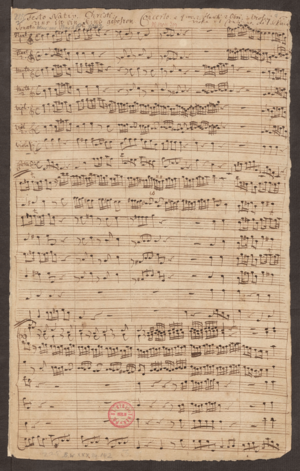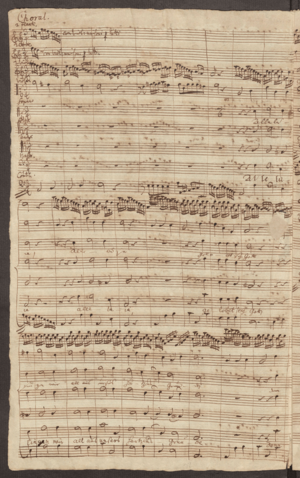Uns ist ein Kind geboren, BWV 142 facts for kids
Uns ist ein Kind geboren means "Unto us a child is born." This is a special Christmas cantata (a type of song story) with the number BWV 142. We don't know for sure who composed this beautiful piece of music.
For a long time, people thought the famous composer Johann Sebastian Bach wrote it. But now, music experts aren't so sure. Some even think it might have been written by Johann Kuhnau, who was a music director before Bach in Leipzig. The words for the cantata were written by Erdmann Neumeister and first published in 1711.
Contents
What is a Cantata?
A cantata is like a mini-opera without acting or costumes. It's a musical story, often for a choir, solo singers, and an orchestra. Christmas cantatas, like this one, tell stories or share feelings about the Christmas season.
Instruments and Voices
This cantata uses several different voices and instruments to tell its story. It features three solo singers: an alto (a lower female voice), a tenor (a higher male voice), and a bass (a lower male voice).
There's also a four-part choir, which means the choir sings in four different voice groups. The instruments include two alto recorders, two oboes, two violins, a viola, and a continuo. The continuo usually involves a cello and a keyboard instrument like a harpsichord, providing the musical foundation.
The Music's Parts
The cantata is divided into eight different sections, called movements. Each movement has its own unique sound and purpose.
1. Sinfonia
This is an instrumental opening, like a mini-concert for the instruments. It features the two alto recorders, two oboes, and the string instruments (violins and viola).
2. Chorus: Uns ist ein Kind geboren
This part is sung by the choir. It's a "double fugue," which means two main musical ideas or tunes are played and sung at the same time, weaving in and out. The first tune is set to "Uns ist ein Kind geboren" (Unto us a child is born), and the second is "Eins Sohn ist uns gegeben" (A son is given to us).
3. Aria (Bass): Dein Geburtstag ist erschienen
An aria is a song for a single singer. In this movement, the bass singer takes the lead. He is joined by two violins playing special, important parts, along with the continuo.
4. Chorus: Ich will den Namen Gottes loben
This is another short piece for the choir. It starts with a "fugato" section, which is like a short fugue where the different voice parts enter one after another. After this, all the voices sing together in a more unified way.
5. Aria (Tenor): Jesu, dir sei Dank
This is a relatively short aria for the tenor singer. He is accompanied by two oboes playing their own special parts. It's a "da capo aria," meaning the first section is repeated at the end.
6. Recitative (Alto): Immanuel!
A recitative is a part where the singer "sings" in a way that sounds like talking. It helps move the story along. Here, the alto singer sings the word "Immanuel!"
7. Aria (Alto): Jesu, dir sei Preis
This aria is for the alto singer. It uses new words but has music that is very similar to the tenor aria (movement 5). Instead of oboes, the alto recorders play the accompanying parts.
8. Chorus: Alleluia
This is the grand finale! The alto recorders, oboes, and violins play fast, continuous notes together. Over this exciting music, the choir sings a four-part song, line by line, ending the cantata with "Alleluia."
English Translations
In 1939, a person named Sydney Biden translated the cantata into English. He titled it For us a child is born.
Other Uses of the Music
Sometimes, parts of this cantata have been used in new ways. For example, in 1940, the composer William Walton used the music from the first bass aria (movement 3) for dance music in a ballet called The Wise Virgins. Also, the final chorus has been arranged for organs and brass instruments to be played separately.
Recordings
Many groups have recorded this cantata so people can listen to it today. Some recordings include:
- Alsfelder Vokalensemble / I Febiarmionici, Wolfgang Helbich. The Apocryphal Bach Cantatas II. CPO, 2001.
- Choir and Orchestra "Pro Arte" Munich, Kurt Redel. J. S. Bach: Magnificat in D Major & Cantata BWV 142. Philips, 1964.
- Mannheim Bach Choir / Heidelberger Kammerorchester, Heinz Markus Göttsche. J. S. Bach: Cantatas BWV 62 & BWV 142. Da Camera, 1966.
- Capella Brugensis / Collegium instrumentale Brugense, Patrick Peire. 'Uns ist ein Kind geboren', Eufoda, 1972
See also
 In Spanish: Uns ist ein Kind geboren, BWV 142 para niños
In Spanish: Uns ist ein Kind geboren, BWV 142 para niños



